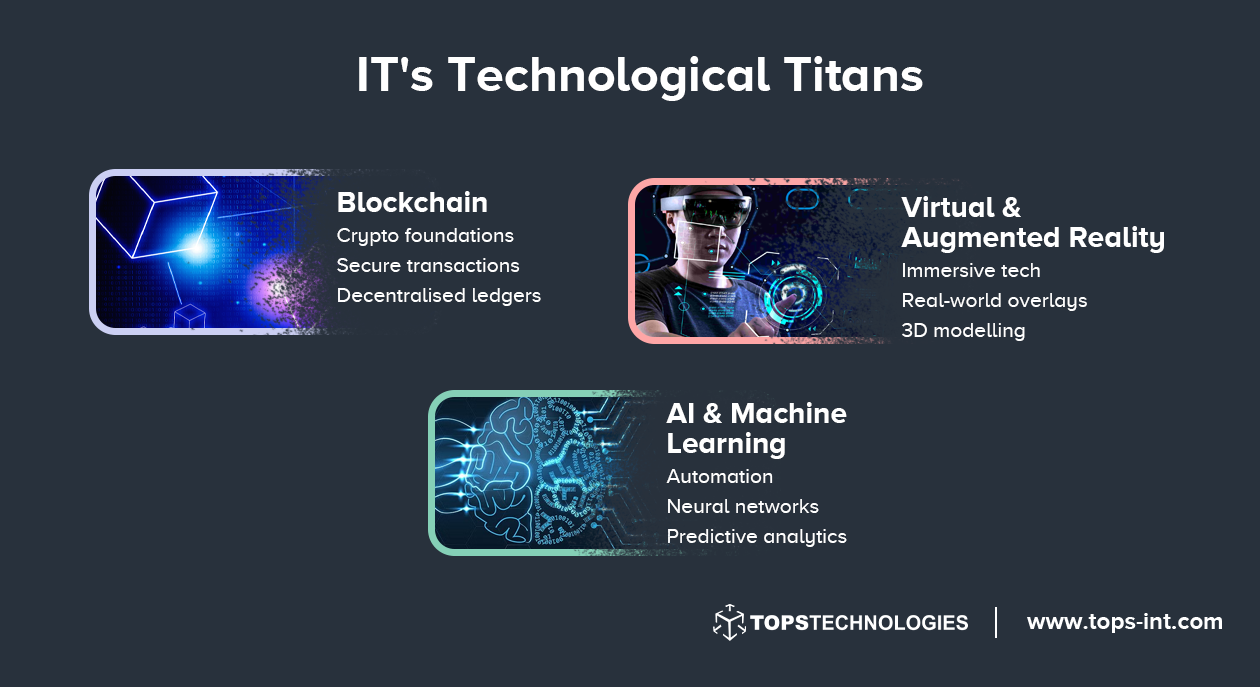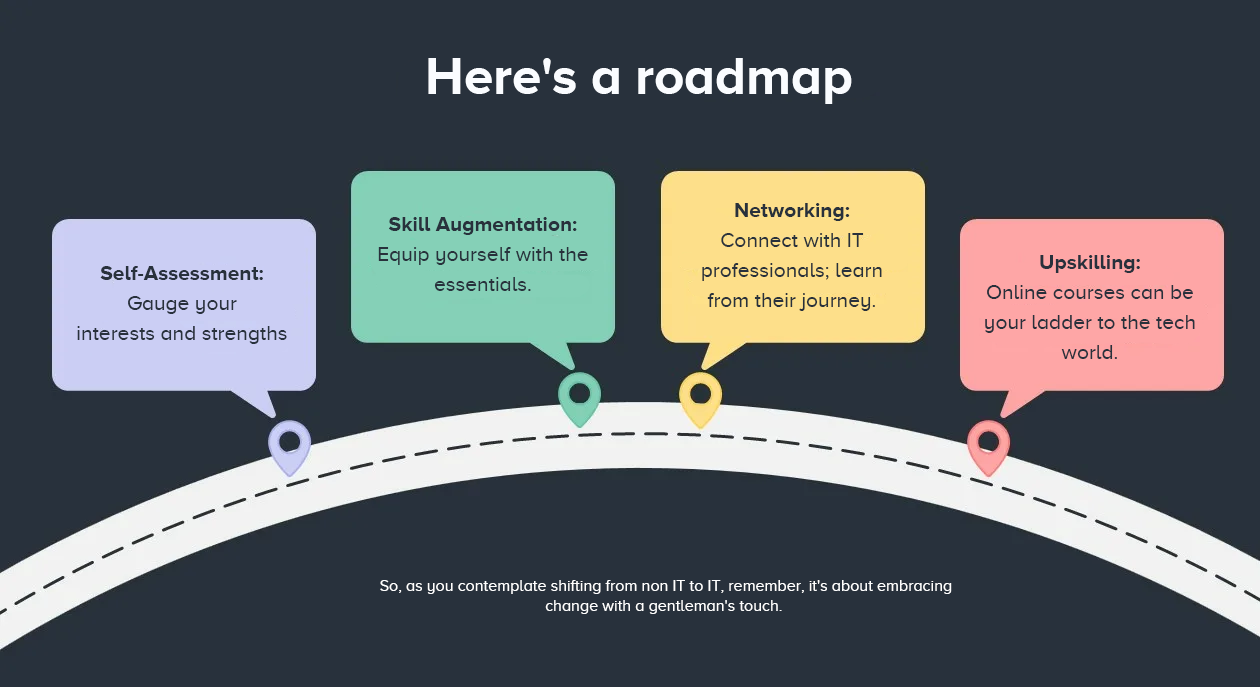A remarkable 40% of professionals in India are venturing into IT from diverse backgrounds. The demand for Software Testing Courses in Ahmedabad and other tech hubs is also increasing. The allure of tech has led many to reimagine their careers. It's not just about coding; business analysis, project management, and design are vibrant avenues.
Are you curious about the journey from non-IT to IT? Surprisingly, the door is wider open than you might think. In India, IT opportunities have surged, beckoning non-IT professionals to explore this domain.
You don't need to be a tech genius or start from scratch. Transferable skills are gems: problem-solving, communication, and adaptability are your allies. Companies value diverse perspectives for holistic innovation.
Here's a roadmap:
So, as you contemplate shifting from non-IT to IT, remember, it's about embracing change with a gentleman's touch.
Choosing the Right IT Domain
Stepping into the world of IT can feel like venturing into a vast ocean of opportunities. But here’s a secret: it doesn’t have to be overwhelming! Let's dive deep and explore the
fascinating realms of IT.
Web Development and Software Engineering
Web development offers you a canvas to build stunning websites and web applications. If you're inclined towards coding and have a knack for design, this could be your niche. And for those who dream bigger?
Software engineering allows you to create software that can change the world. There are many courses with placement available to help you learn.
Data Science and Analytics
For maths lovers and pattern finders, data science and analytics can be a treasure trove. Dive into the world of numbers and predict future trends, or unravel hidden insights from chunks of data.
Networking and System Administration
Suppose you're the go-to person when the Wi-Fi goes down or a computer glitches; consider a career in networking or system administration. You'll be the backbone of IT infrastructure, ensuring everything runs smoothly.
Digital Marketing
Does the online world intrigue you? Digital marketing is a blend of creativity and technology. You could strategize campaigns, dive into SEO, or even manage online reputations.
Cloud Computing and Cybersecurity
With businesses migrating online, the need for robust cloud solutions and security has skyrocketed. If safeguarding online realms or innovating in the cloud excites you, this could be your calling.
Consider your passions, and align them with potential job prospects. After all, with the right domain, and the right course, the sky's the limit. Start your search today and secure those dream-it jobs for freshers!
Building a Strong Foundation
Computing and technology have firmly rooted themselves in the 21st century. Whether you're looking to kickstart a tech career or enhance your skills, understanding fundamental concepts is paramount. So, where do you begin? Let’s navigate this roadmap together.

Computer Fundamentals
Here is a deep dive into the fundamentals:
Understanding Hardware & Software
- Hardware forms the physical components, like RAM, CPU, and hard drives.
- Software, on the other hand, includes the applications and OS that drive these components.
Operating Systems
This is the bridge between the user and the hardware. Knowing how OSs like Windows, macOS, or Linux operate is foundational.
- Network Basics: Understand the difference between LAN, WAN, and the magic behind the internet.
- Storage Concepts: Grasp the nuances between HDDs, SSDs, and how cloud storage functions.
Programming Languages
Languages like HTML, CSS, and JavaScript are staples. For server-side scripting, consider PHP or Node.js. Seeking a comprehensive Web Designing Course is a step in the right direction.
- Game Development: Delve into C# for Unity or C++ for Unreal Engine.
- Mobile App Development: Java for Android and Swift for iOS are crucial.
Object-Oriented Programming (OOPs) and Data Structures & Algorithms (DSA)
Learn about Classes, Objects, Inheritance, Polymorphism, Abstraction, and Encapsulation. OOP makes software design intuitive and reusable.
For instance, Python’s simplicity makes it an excellent starting point for OOP.
Data Structures
- These are ways to organise data. Understand Arrays, Linked Lists, Trees, and Graphs.
- Implementing data structures efficiently can significantly optimise performance.
Algorithms
- These are predefined instructions to solve problems. Grasping, searching, and sorting algorithms are foundational.
- DSA enhances problem-solving skills—a must for tech interviews.
Machine Learning and AI
With the surge in demand for intelligent applications, machine learning and AI have taken centre stage. Whether it’s chatbots, recommendation systems, or advanced robotics, the potential is boundless. If you're in the vicinity of Ahmedabad, consider pursuing Python Training in Ahmedabad, as Python remains the language of choice for many AI projects.
Data Visualization
An essential part of the data analytics pipeline, visualisation enables the representation of data in graphical form. Tools like Tableau and Power BI dominate this space, making complex data comprehensible. Explore Data Analytics Courses in Ahmedabad to grasp the subtleties of transforming raw data into actionable insights.
Backend Development
While the front end of a website caters to design and user experience, the back end ensures everything runs smoothly. Languages like Python, Ruby, and Java are commonly employed. Databases like SQL and NoSQL form an essential part of this domain.
Cloud Computing
With businesses shifting online, understanding cloud platforms like AWS, Google Cloud, and Microsoft Azure can be a game-changer. They offer scalable solutions and are reshaping the way industries operate.
DevOps
Integrating development and operations, DevOps emphasises collaboration and automation, reducing the system development life cycle while ensuring high software quality.
Whether you’re inclined towards data, love coding, or have an eye for design, there's something for everyone.

Hands-On Learning and Practice
Diving deep into the IT world isn't just about attending lectures or reading countless books. The real essence of understanding tech lies in hands-on learning and consistent practice. Think of it like learning to ride a bike; you don’t master it by just watching others ride.
Structured Learning Paths and Resources
Charting a structured learning path is the first step. With so many job vacancies popping up daily, it’s crucial to align your learning with its job qualifications.
Curate resources that match the skills in demand, from online courses to interactive tutorials. Tailored learning paths not only provide direction but also ensure that you're well-prepared for the evolving IT landscape.
Daily Practice Routines
Consistency is the name of the game. Dive into daily coding challenges to sharpen your problem-solving skills.
Platforms like LeetCode or CodeWars can be goldmines for hands-on coding practice. Beyond individual endeavours, immerse yourself in tech communities.
Engaging with peers, participating in hackathons, or even discussing the latest tech trends can provide invaluable insights.
Upcoming Trend: Keep an eye out for Python Training in Surat. It’s rapidly becoming a fundamental aspect of computer education.

Project Development
Entering the IT realm, especially when shifting from non-IT to IT, can feel like stepping onto a different planet. But fret not! Building real-world projects can act as your compass in this new territory. Here's a step-by-step guide to give you a head start.
1. Ideation and Scope
Start by identifying a problem you're passionate about solving. It doesn’t have to be groundbreaking; simplicity can be the key. For someone shifting from non-IT to IT, even replicating an existing solution with a twist can provide immense learning.
2. Research and Planning
Before diving in, spend time researching. Understand the tools and technologies relevant to your project. Create a roadmap to ensure you cover all aspects of development.
3. Collaboration
Teamwork makes the dream work. Collaborating exposes you to diverse thought processes and problem-solving techniques. It's an invaluable experience, especially when transitioning from non-IT to IT.
4. Version Control
This is where tools like Git come into play. They allow you to track changes, revert to previous versions, and collaborate smoothly. Version control is crucial for organised and efficient development.
5. Development and Iteration
Start building. Your first version might be far from perfect. Feedback and iteration are your best friends. Use them generously.
6. Testing
Once you've built your project, test it. Look for bugs, evaluate user experience, and ensure everything works seamlessly.
7. Portfolio Building
As someone moving from non-IT to IT, showcasing your work becomes paramount. Create a portfolio that not only displays your projects but also details your journey, the challenges faced, and the solutions implemented.
8. Reflection and Learning
Post-completion, reflect on what went right and what didn’t. Such introspection can be a goldmine for learning.
In essence, project development isn't just about coding. It's a holistic process that entails planning, collaboration, execution, and reflection. For those making the leap from
non-IT to IT, it’s an authentic and impactful way to showcase your skills and adapt seamlessly to the tech world. Enroll in the
best courses for IT jobs and learn about project
development.
Resume and Interview Preparation
Highlight tech skills upfront; showcase programming languages, tools, and platforms.
You also need to incorporate quantifiable achievements, e.g., "Increased website speed by 30%."
List relevant IT certifications and courses. Include any tech projects or apps developed, even if they were personal or academic.
Mock Interviews
- Simulate real interview settings to build confidence.
- Record sessions to review answers and body language.
- Seek feedback from mentors or peers in the IT sector.
For those transitioning, be ready to discuss the shift, e.g., "Why are you shifting from non-IT to IT?"
Conclusion
Stepping into the IT domain can seem daunting. However, with a pioneer like TOPS Technologies by your side, the transition becomes seamless. Boasting 15 years of experience in the IT Training and placement industry, we've sculpted a legacy. With over 1 lac students placed and collaborations with 3000+ companies, TOPS Technologies provides a robust platform for aspirants.
Our widespread presence, marked by
19+ offices across India, ensures you're never too far from expert guidance. Whether you're eyeing a software developer role or inclined towards a
Software Testing Course in Ahmedabad,
TOPS Technologies is your launchpad to IT excellence.
FAQs
Is it possible to transition to IT without a prior tech background?
How long does it typically take to transition?
It varies, but committing to rigorous training and hands-on projects can expedite the process.
Are there specific courses that can help?
Yes, courses tailored to your desired IT role are beneficial. For instance, if QA intrigues you, consider enrolling in a course.
Do companies hire freshers from non-IT backgrounds?
Certainly! With the right skill set and training, many companies value the diverse perspectives that non-IT individuals bring.
How can I ensure a smooth transition?
Enroll in institutions like TOPS Technologies, practice hands-on projects, and continuously upgrade your skill set.









